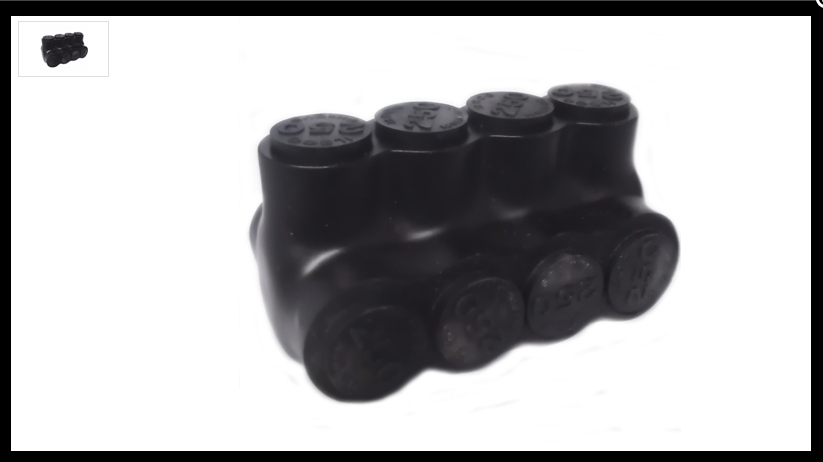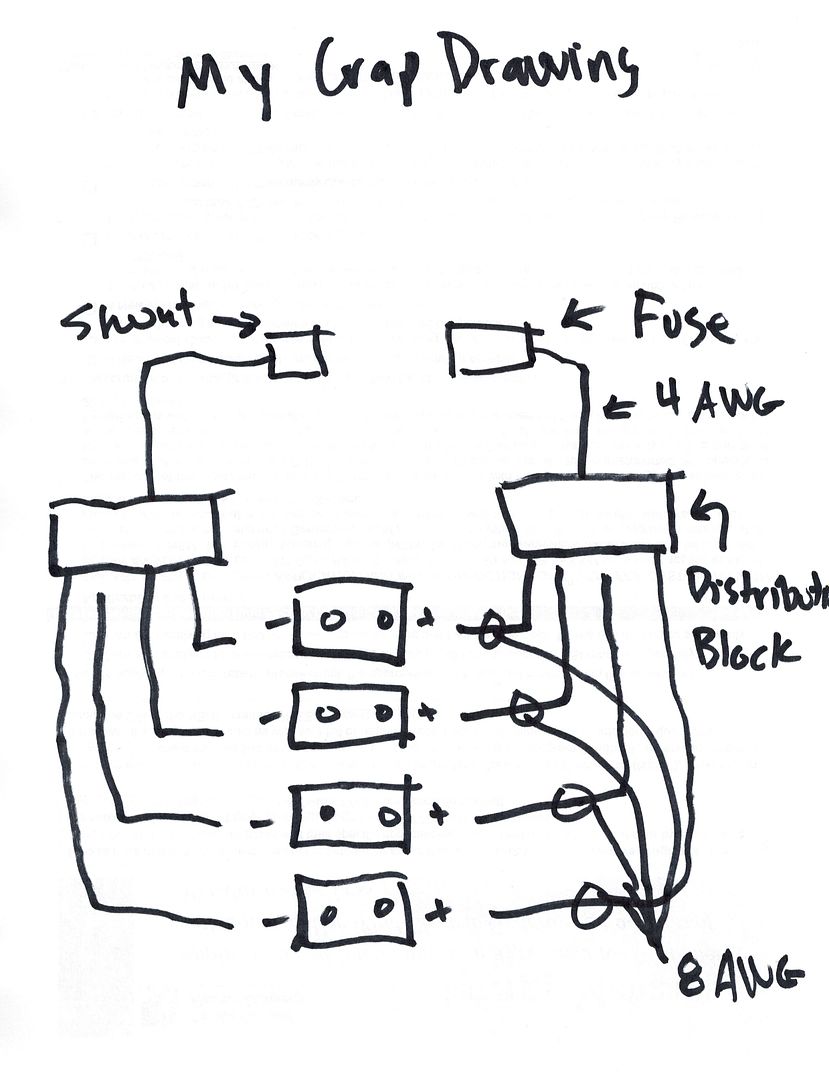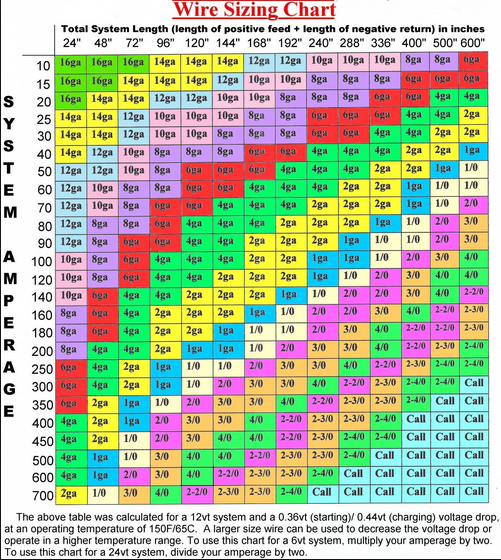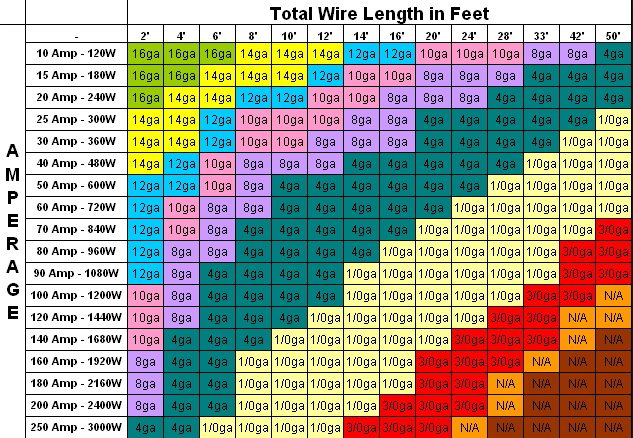Best 400 / 600 ah Battery Bank Configuration (12v)
semsoblue
Registered Users Posts: 12 ✭
Looking for some opinions on battery bank configurations. If space was not a concern, what would your ideal 12v battery bank look like? I've read some going for 6v wired in series or series/parallel, for "thicker plates" and easier equalization. Others opting for 12v batteries in parallel so that if one battery goes bad, you can still run your system.
What batteries would you get for a 400ah configuration? 600ah?
What batteries would you get for a 400ah configuration? 600ah?
Comments
-
Re: Best 400 / 600 ah Battery Bank Configuration (12v)
Personally, I am the guy that recommends you, ideally, find cells/batteries that will give you a 12 volt battery bank at your AH rating (I am not saying "buy this"--Just examples of different batteries/configurations):
Single 12 volt battery:
Crown Industrial Battery - 12 Volts, 625 Amp-hours
Or you can get pair of 6 volt batteries in series:
Surrette Battery - 6 Volts, 683 Amp-hours
And there are "monster" 2 volt cells (6 cells in series):
Surrette Battery - 2 Volts, 1050 Amp-hours
Or you can get 3 strings of 2 batteries in series--6volt @ 220 AH:
Trojan T-105 6 Volt, 225 AH Deep Cycle Battery
My recommendation is to aim for a single string of ~400-600 AH batteries, and put them in series (if needed) to give you a 12 volt @ X00 AH battery bank. 6 cells to check water levels on. Once set of cables to maintain, etc.
Some folks like to put two 1/2 AH rated strings in parallel--If one cell/battery "dies", you have a second 1/2 size string to keep running at reduce power until you can replace the cells. If you are in the "middle of nowhere" with 4 feet of snow--That might be a good backup plan.
In general, the more parallel strings you have--The more issues you have. More cells to check water on, more cables to check, you should have a fuse/breaker per string (more costs) to prevent a short circuit from starting a fire, batteries do not "share current well" (you need to build a "balanced" cabling scheme), temperature variation can cause different battery string to "steer current" in an unbalanced manner, more connections+cells means more chances will "something" can fail, etc.
On the other hand, a bank of 2-3 strings of 6 volt @ 220 AH "Golf Cart" batteries is not a bad bank. It is cheap, relatively rugged and reliable, and will probably last you 3-5 years--Unless you have a major "oops" (and most first timers have a major oops with their first bank or two--and having cheaper batteries being murdered feels better than having an expensive bank of 8 year life batteries murdered).
In the end, you need to see what is available "local" to you. Many places only have truck batteries available (as heavy duty batteries--You do not want to take truck/marine batteries to 50% or less deep cycling--They will not usually last very long)--And that is the best they can do. Some places (port cities for example) may have electric fork lift batteries available.
And--Look at the physical size/weight of the cells. A single 12 volt @ 625 AH battery weighs something like 510 lbs/230 kG (without palett/packaging). If you cannot move that (no crane, forklift, concrete floor+pallet jack, truck with lift gate, steps to basement, etc.)--Then getting physically smaller cells/batteries and building up you battery bank is your only option (50-100 kG cells with 1-2 people).
I can make suggestions--But you will have to make the decisions (lots of shades of gray/grey). Read about batteries--There is a lot to pay attention to:
http://www.windsun.com/Batteries/Battery_FAQ.htm
http://www.batteryfaq.org/
http://batteryuniversity.com/
-BillNear San Francisco California: 3.5kWatt Grid Tied Solar power system+small backup genset -
Re: Best 400 / 600 ah Battery Bank Configuration (12v)Looking for some opinions on battery bank configurations.
In my opinion, you should configure your batteries based on facts, not opinions. The facts are that for batteries that cycle a single series string is optimal. That doesn't mean that parallel configurations can't or don't work, it just means they are not optimal.
short discussion here: http://forum.solar-electric.com/showthread.php?14674
--vtMaps4 X 235watt Samsung, Midnite ePanel, Outback VFX3524 FM60 & mate, 4 Interstate L16, trimetric, Honda eu2000i -
Re: Best 400 / 600 ah Battery Bank Configuration (12v)
I bought 12 cells of 600 AH batteries for $630 which gives me 1200 AH @ the 8 hour rate. I have had great success with these and purchased them used. I can trade them in for scrap when they won't run anything anymore, but they are very strong and kick butt! They have run saws, tools, household stuff, heck even the AC at times and they have lots of guts to do it just fine. They were going to the smelter and I just pay a bit over the scrap value of the units. They are AGM and very high quality as well. They have been working for well over a year and and give me backup to do more than I would otherwise. With 2 strings, I can have backups when any fail so I just will plug them in as needed. The plan is to have them run a frig and chest freezer, but also be available for backup duty if needed.
I travel to the last place before a company loads batteries on a truck to the smelter, so it may not work well for you. If you are a very long way from a supplier, shipping is always an issue with batteries. I made 3 trips to get 56 cells of 1040 AH in a pickup. That gives me 2 strings of 1040 AH (2080 AH because they are wired in parallel) with 6 spares. That cost me $1300 plus lead weight trade in and 24 gallons of diesel. They have been wonderful and I can even heat with the heat pump from batteries. I don't think many here heat with batteries, but it works for me.
Good luck, keep an open mind, and let us know how it works out. I did most of my system on the cheap.
Skip12K asst panels charging through Midnite Classic 150's, powering Exeltechs and Outback VFX-3648 inverter at 12 and 48 volts. 2080 AH @ 48 VDC of Panasonic Stationary batteries (2 strings of 1040 AH each) purchased for slightly over scrap, installed August 2013. Outback PSX-240X for 220 volt duties. No genny usage since 2014. -
Re: Best 400 / 600 ah Battery Bank Configuration (12v)
Thanks. I'm leaning towards getting 2 of the Trojan L16H 6v, 435Ah, and wiring in series. They are expensive here, over $500 each.
I could use some help on the details. Do I only need a fuse on the load side of the positive lead, since I'm wiring series, I assumed I would not need to fuse that. Is that right? What size/type of fuse, what awg cable, any input on wiring would be helpful. Any of the common mistakes newbies make that I can at least try avoid:)
For the IOTA, I need the 220/240 version, and I believe it only goes up to 55amps. Would you all recommend that size? -
Re: Best 400 / 600 ah Battery Bank Configuration (12v)
I highly recommend a fuse/breaker for any battery connections. Especially when you are working on batteries that are 5-8x larger than a standard car battery. They are capable of pretty much catching the heaviest cable on fire/melting it if there is a dead short somewhere.
You are building a system that you need to trust will not do harm to your home/family 24 x 7 for many years to come. Using a fuse/breaker to prevent problems is critical.
In theory, if you run a very simple set of cables from your one series string to the + and - bus bars/common connection point. And you insulate metal corners, tie the cables so they cannot fall into something and get shorted, and you cover the battery bank to prevent tools/metal objects from falling onto the battery bank (in a business, the battery bank would be behind locked doors)... Then you may choose to not use a breaker on the main leads, but use breakers/fuses on each of the leads that leave the positive bus bar (fuses/breakers protect wiring. The wiring should be large enough to carry your loads and the protective device should trip before the wiring is damaged in a dead short).
So--I think I have done the math for you. First figure out the largest continuous current you will draw. It can be the largest inverter load, it can be the largest charging current--etc... Some rules of thumbs for a "generic 12 volt system" based on your 12 volt @ 435 AH battery bank (using flooded cell storage batteries design rules).- 435 amps * 1/2.5 maximum surge current = 174 Amps maximum surge current (a few minutes)
- 435 amps * 1/5 max discharge for an hour or so = 87 amps max continuous hour or two current
- 435 amps * 1/8 max till dead = 54.4 amp taking battery to dead rate (don't discharge below ~50% in normal operation for long battery life)
- 435 amps * 1/20 typical loads = 21.75 amps typical average current (4 hours for two nights to 50% discharge)
- 1,200 watt inverter * 1/0.85 inverter eff * 1/10.5 battery cutoff voltage = 134.5 amps max continuous draw from AC inverter
- 435 AH * 5% rate of charge = 22 amps minimum recommended rate of charge
- 435 AH * 10% rate of charge = 43.5 amps nominal rate of charge
- 435 AH * 13% rate of charge = 56.6 amps "cost effective solar" rate of charge
- 435 AH * 20% rate of charge = 87 amps very heavy charge (usually from AC mains/generator)
- 435 AH * 25% rate of charge = 109 amps recommend not to exceed (from AC mains/generator)
So, the above sort of sets your maximum/typical/average expected power usage and charging current for your proposed battery bank.
Say you pick a 1,200 watt AC inverter and want to use that to maximum capabilities:- 1,200 Watts * 1/0.85 inverter eff * 1/10.5 battery cutoff * 1.25 NEC derating = 168 amps minimum branch circuit + fuse rating
- And you need to check for maximum voltage drop (short/heavy cables--Usually around 0.5 volts maximum)
Similar for your chargers. A 10% rate of charge (nominal solar/generator/AC mains) would be:- 435 amps * 0.10 rate of charge * 1.25 NEC derating = 54.4 amp minimum cable/fuse rating
- And check for maximum wiring voltage drop of ~0.05 to 0.10 volts for 12 volt battery charging (too much drop will slow down charging speed)
And, the solar array--We have to recommendations... First the size of the array based on battery capacity (5% to 13% rate of charge--Bigger battery bank needs larger solar array for proper charging). And second, the number of hours per day of sun you expect for your location to make up daily usage.- 435 AH * 14.5 volts charging * 1/0.77 panel+controller deratings * 0.05 rate of charge = 410 Watt array minimum
- 435 AH * 14.5 volts charging * 1/0.77 panel+controller deratings * 0.10 rate of charge = 819 Watt array nominal
- 435 AH * 14.5 volts charging * 1/0.77 panel+controller deratings * 0.13 rate of charge = 1,065 Watt array "cost effective maximum"
But, what are your loads? A nice "nominal" battery bank would be discharge 25% per day for two days, to 50 discharge:- 435 AH * 12 volts * 0.25 discharge * 0.85 inverter eff = 1,109 Watt*Hours per day of "useful" AC power
And based on hours of sun per day. Find a city near you using the Solarelectrichandbook. Here is Lima Peru with fixed south facing array tilted to latitude:
Measured in kWh/m2/day onto a solar panel set at a 78° angle (from vertical, or 22 degrees from horizontal):
(For best year-round performance)
Jan
Feb
Mar
Apr
May
Jun
5.77
5.58
5.82
6.12
6.09
5.61
Jul
Aug
Sep
Oct
Nov
Dec
5.78
5.94
5.91
5.71
6.35
6.27
Lima looks like it gets lots of sun... I typically toss the bottom 3 months (I assume using generator to make for bad weather)--But in this case, I will use 5.0 hours of sun minimum (not much generator use, a little buffer in case your loads grow).- 1,109 WH per day of AC power * 1/0.52 end to end system eff * 1/5.0 hours of sun per day = 426 Watt solar array minimum (based on my guess of your loads and hours of sun per day)
So--As you can see, everything is based on everything else. Your loads define the battery bank. The battery bank defines the size of the array. The battery bank and hours of sun also define the array. In the above case study, we are looking at a minimum of 426 watt array to a nominal/maximum of 819/1,065 watt array (in round numbers).
The size of the battery bank sets physical limits on the amount of power/current you can discharge/recharge. And those numbers have to somewhat match your needs to power your loads.
Note that a 1,200 watt inverter running flat out at 1,200 watts will pretty much burn up your power budget in 1 hour per day for two days.
A 300 watt inverter running at 300 watts will run about 4 hours per day for two days... A much better match if you want 4-5 hours of lights+computer+etc. per night.
It always comes back to loads and conservation for a successful installation.
And the loads will drive the maximum current through the wiring--Which then sets the minimum wiring / maximum fuse+breaker ratings.
Sort of make sense?
-BillNear San Francisco California: 3.5kWatt Grid Tied Solar power system+small backup genset -
Re: Best 400 / 600 ah Battery Bank Configuration (12v)
Bill,
Thanks very much for the detailed info. It's a lot to wrap my head around, but I understand the concepts. Some have recommended looking into AGM batteries. I've noticed they are harder to find in the higher ah rating. What are your thoughts on an AGM bank? How would that change the system design? Would the IOTA chargers still work for those? -
Re: Best 400 / 600 ah Battery Bank Configuration (12v)Bill,
Thanks very much for the detailed info. It's a lot to wrap my head around, but I understand the concepts. Some have recommended looking into AGM batteries.
If you notice, I ask lots of questions and give "open source" answers that don't have a lot of fuzz in them (aka math). The reason I do that is "you" need to understand how things fit together so you can adjust them to your needs (which you know, and I have no clue).
And that includes charge controllers, inverters, solar panels, and batteries which you can obtain locally (and not familiar to others in the US). So, many times, you are going to have to "adjust" the system to match the cost effect components are available to you.
Similar with AGM batteries--There are some very nice brands in the US and Europe--And depending on where they import from (or manufacture locally), you hopefully can find some that meet your needs.
In general, a good recommendation is to get a "cheaper" decent quality Flooded Cell battery (we use Golf Cart and similar batteries in the US) that will easily last 3-5 years for not too much money--And after that period of time (and possibly murdering your first set), you will have your needs/system dialed in and you can go with AGM or other better quality batteries--Or make your system larger/smaller without having to figure out what to do with $$$$ 10+ life batteries.
And specificially, my system is Grid Tied--I don't have any battery experience in off grid/solar systems. I am approaching the problem as an engineer. Qualify your needs, figure out the products you can buy that will support those needs... Then check with friends, local sources, etc. to see how the products work over time.
It is this last one--That I (personally) cannot cannot really give you any advise--There is a reason they don't let engineers near the purchasing department.I've noticed they are harder to find in the higher ah rating. What are your thoughts on an AGM bank? How would that change the system design? Would the IOTA chargers still work for those?
They do make other "sealed batteries"... VRLA (valve regulated lead acid) are very common in the ridiculously large AH variety. Used around telecom/industrial/computer backup/electric vehicles and such.
But you have to make sure they will meet your needs. Telecom/UPS batteries are deigned for float service, not daily cycling.
Some industrial batteries (flooded cell) designed for heavy cycling can require very high charging voltages for proper recharging (15-16+ volts). And many AC inverters will have the battery cutoff voltage set at 15.0 volts--So the inverter may shut down when you are charging during the day/especially if the battery bank is very cold (cold battery bank needs higher charging voltages).
Find a local battery supplier and see if they can help you... This stuff is complex and sometimes, it is not easy to get the details you need (charging voltages and current, cycling life, etc.). If you cannot get the needed information (or the vendor tells you not to use them for solar/off grid power)--Then look for something else.
-BillNear San Francisco California: 3.5kWatt Grid Tied Solar power system+small backup genset -
Re: Best 400 / 600 ah Battery Bank Configuration (12v)looking into AGM batteries. I've noticed they are harder to find in the higher ah rating. What are your thoughts on an AGM bank? How would that change the system design? Would the IOTA chargers still work for those?
I agree with Bill... don't use AGMs for your first battery bank.
When you design your battery bank, remember that a single series string is optimal. That is especially so with AGM batteries. The lower internal resistance of AGM batteries means that the resistance of all the extra connections and fuses (needed with a parallel bank) will have a greater deleterious effect on AGMs than flooded batteries.
--vtMaps4 X 235watt Samsung, Midnite ePanel, Outback VFX3524 FM60 & mate, 4 Interstate L16, trimetric, Honda eu2000i -
Re: Best 400 / 600 ah Battery Bank Configuration (12v)
Thanks guys. I'm still looking at flooded batteries, but will shoot for as few strings as possible. Any recommendations on a good DC clamp meter? -
Re: Best 400 / 600 ah Battery Bank Configuration (12v)
"Good enough" is the $60 USD version from Sears. Get a friend in the US to try an mail you one (or bring it down in their luggage).
http://www.sears.com/shc/s/p_10153_12605_03482369000P
It is actually the same meter as the Extech MA440 (now discontinued?)... Other meters from them include:
http://www.extech.com/instruments/categories.asp?catid=4
If you want a "good meter"--Fluke is the standard in the field:
http://www.fluke.com/fluke/uken/products/category.htm?category=CLMP%28FlukeProducts%29
-BillNear San Francisco California: 3.5kWatt Grid Tied Solar power system+small backup genset -
Re: Best 400 / 600 ah Battery Bank Configuration (12v)
Guys,
I could use some specific input on finishing the design of this system. I've bought most of the components, and we leave on Monday for the Jungle. So I need to buy busbars, fuses, cable lugs, etc, and need some help. I've attached a diagram of the components, and wanted input on how I should connect them, fuse sizing, etc. The components are : 2-Trojan 12v 225ah batteries, 1-IOTA 55 charger, 1-Victron Phoenix 12v-220v 350W Inverter, 1-12v-220v 1000w Peruvian Inverter (mod.sine, 5w idle cons), 1-Victron BMV 600 Battery Monitor. Planning for 3 DC circuits and 3 AC circuits. Loads are in the diagram. Can you give me some direction on finishing it out? Should I list this as a new post also?Attachment not found. -
Re: Best 400 / 600 ah Battery Bank Configuration (12v)
I personally just buy the cheap batteries AGM's @ about 100ah to 125ah per battery. Run 4 or 5 of them in parallel configuration via B-Line or Brundy distribution block.
Then wire up a B-Line distribution block. Distribution blocks offer maximum flexibility rated @ 600V DC or AC.
You will need a 100 AMP inline fuse between inverter and battery system 12V DC X 100 AMP DC= 1200watts DC for 1000 watt pure sine wave AC, never pay attention to continuous out put as the duration is limited to internal capacity of inverter. 4AWG is limited to under 6' of length if you are concerned with continuous cycling and voltage drop, you could go chunkier with a 1AWG for a longer length than 6'.
Wire sizing Chart based on LF.

-
Re: Best 400 / 600 ah Battery Bank Configuration (12v)Guys,
I could use some specific input on finishing the design of this system. I've bought most of the components, and we leave on Monday for the Jungle. So I need to buy busbars, fuses, cable lugs, etc, and need some help. I've attached a diagram of the components, and wanted input on how I should connect them, fuse sizing, etc. The components are : 2-Trojan 12v 225ah batteries, 1-IOTA 55 charger, 1-Victron Phoenix 12v-220v 350W Inverter, 1-12v-220v 1000w Peruvian Inverter (mod.sine, 5w idle cons), 1-Victron BMV 600 Battery Monitor. Planning for 3 DC circuits and 3 AC circuits. Loads are in the diagram. Can you give me some direction on finishing it out? Should I list this as a new post also?Attachment not found.
You/we need some more information which you probably won't be able to supply not being at the location. Namely the lengths of the wiring involved, as it has to meet both the current carrying and the Voltage drop specifications.
It will help you a lot if you can get the manuals for the equipment involved and read what the manufacturers have to say about current, wire sizes, and recommended fuses/breakers.
The AC wiring will be according to whatever passes for standard there or the 'default' methods used for European wiring (230VAC 50Hz). I don't know what the output of your inverters is: socket or hardwire. Looks like hardwire. You will want to avoid putting the output of both to the same AC distribution panel: one wrong wire and the inverters could blow.
Keep in mind the wiring from the batteries to the inverters will carry the most current, and so need to be heaviest and shortest. A 350 Watt inverter draws about 35 Amps on 12 Volts (based on maximum power out and minimum Voltage in). A 1kW inverter draws about 100 Amps.
Otherwise you're doing fine with your diagram. It may help you to not try and fit all the wires in at once, but treat the connections individually. All the DC hook-ups will go to the bus bars.
Categories
- All Categories
- 233 Forum & Website
- 141 Solar Forum News and Announcements
- 1.4K Solar News, Reviews, & Product Announcements
- 199 Solar Information links & sources, event announcements
- 900 Solar Product Reviews & Opinions
- 256 Solar Skeptics, Hype, & Scams Corner
- 22.5K Solar Electric Power, Wind Power & Balance of System
- 3.5K General Solar Power Topics
- 6.7K Solar Beginners Corner
- 1K PV Installers Forum - NEC, Wiring, Installation
- 2.1K Advanced Solar Electric Technical Forum
- 5.6K Off Grid Solar & Battery Systems
- 429 Caravan, Recreational Vehicle, and Marine Power Systems
- 1.1K Grid Tie and Grid Interactive Systems
- 656 Solar Water Pumping
- 816 Wind Power Generation
- 624 Energy Use & Conservation
- 623 Discussion Forums/Café
- 315 In the Weeds--Member's Choice
- 75 Construction
- 125 New Battery Technologies
- 108 Old Battery Tech Discussions
- 3.8K Solar News - Automatic Feed
- 3.8K Solar Energy News RSS Feed
